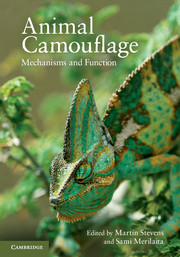Book contents
- Frontmatter
- Contents
- Contributors
- 1 Animal camouflage
- 2 Crypsis through background matching
- 3 The concealment of body parts through coincident disruptive coloration
- 4 The history, theory and evidence for a cryptic function of countershading
- 5 Camouflage-breaking mathematical operators and countershading
- 6 Nature's artistry
- 7 Camouflage behaviour and body orientation on backgrounds containing directional patterns
- 8 Camouflage and visual perception
- 9 Rapid adaptive camouflage in cephalopods
- 10 What can camouflage tell us about non-human visual perception? A case study of multiple cue use in cuttlefish (Sepia spp.)
- 11 Camouflage in marine fish
- 12 Camouflage in decorator crabs
- 13 Camouflage in colour-changing animals
- 14 The multiple disguises of spiders
- 15 Effects of animal camouflage on the evolution of live backgrounds
- 16 The functions of black-and-white coloration in mammals
- 17 Evidence for camouflage involving senses other than vision
- Index
- Plate section
- References
13 - Camouflage in colour-changing animals
Trade-offs and constraints
Published online by Cambridge University Press: 05 June 2012
- Frontmatter
- Contents
- Contributors
- 1 Animal camouflage
- 2 Crypsis through background matching
- 3 The concealment of body parts through coincident disruptive coloration
- 4 The history, theory and evidence for a cryptic function of countershading
- 5 Camouflage-breaking mathematical operators and countershading
- 6 Nature's artistry
- 7 Camouflage behaviour and body orientation on backgrounds containing directional patterns
- 8 Camouflage and visual perception
- 9 Rapid adaptive camouflage in cephalopods
- 10 What can camouflage tell us about non-human visual perception? A case study of multiple cue use in cuttlefish (Sepia spp.)
- 11 Camouflage in marine fish
- 12 Camouflage in decorator crabs
- 13 Camouflage in colour-changing animals
- 14 The multiple disguises of spiders
- 15 Effects of animal camouflage on the evolution of live backgrounds
- 16 The functions of black-and-white coloration in mammals
- 17 Evidence for camouflage involving senses other than vision
- Index
- Plate section
- References
Summary
Colour change is widespread in ectotherm animals including crustaceans, insects, cephalopods, amphibians, reptiles and fish (Bagnara & Hadley 1973). There are two types of colour change, morphological and physiological, which differ in their mechanism and speed. Morphological colour change occurs due to changes in the density and quality of pigment-containing cells (chromatophores) in the dermis (a layer of the skin) and usually takes place over a timescale of days or months. For instance, a common form of morphological colour change is long-term background or chromatic adaptation, in which the animal's colour changes to more closely resemble that of the background. Long-term background adaptation involves an increase in both the density of melanophores (melanin-containing chromatophores) and melanin pigment within the melanophores (Bagnara & Hadley 1973; Sugimoto 2002). By contrast, physiological colour change occurs due to movement (dispersion or concentration) of pigment within chromatophores and is much more rapid, taking milliseconds to hours (Bagnara & Hadley 1973; Thurman 1988). For example, short-term background adaptation generally involves movement of melanosomes (organelles containing melanin pigment) within melanophores, either becoming concentrated in the middle, resulting in lightening, or becoming dispersed throughout, resulting in darkening. The exception is cephalopods (squid, cuttlefish, octopuses and their relatives), in which colour change occurs due to contraction of the muscle fibres of specialised ‘chromatophore organs’, which comprise the chromatophore itself surrounded by radial muscle fibres and sheath cells (Bagnara & Hadley 1973; Messenger 2001; Hanlon 2007). In cephalopods, colour change is effected by neural control of muscle contraction within chromatophore organs whereas in other animals, movement of pigment-containing organelles within chromatophores is under neural and/or endocrine control (Bagnara & Hadley 1973; Nery & Castrucci 1997). The majority of early experiments using colour-changing animals focussed on the physiological basis of colour change in fish and amphibians maintained on (i.e. adapted to) black-and-white backgrounds (reviewed in Bagnara & Hadley 1973). However, many animals capable of physiological colour change show much more complex responses to changes in their visual environments than simple adaptation to dark and light backgrounds (Figure 13.1). Consequently, recent studies have manipulated specific visual features, habitat characteristics, perceived predation risk and social environment to assess dynamic, adaptive colour responses. These studies have highlighted the diversity of visual cues and interacting selective pressures influencing the colour patterns and camouflage strategies adopted by colour-changing animals.
Many colour-changing taxa appear to rely primarily on background matching (e.g. amphibians, reptiles, flatfish, insects, crustaceans). One possible reason for this is that in species with more limited capacity for colour change, changes in coloration are often primarily restricted to changes in overall dermal reflectance, with little change in pattern (e.g. most crustaceans, amphibians and reptiles). Nevertheless, physiological colour change potentially enables animals to employ more than one camouflage or anti-predator strategy (e.g. background matching, disruptive coloration, countershading, dazzle markings, warning coloration; see Stevens & Merilaita 2009a, b for definitions and discussion). Although the range of colour patterns exhibited is unknown for most colour-changing taxa, there are a few exceptions. For example, juvenile bullethead parrotfish show three principal physiological colour patterns: stripes, a distinct ‘eyespot’ at the base of the tail fin and a ‘uniformly dark’ pattern (Crook 1997). These three patterns may exploit different camouflage or anti-predator mechanisms. Specifically, the stripes may be associated with disruptive camouflage or motion dazzle (stripes: Stevens 2007), the ‘eyespot’ pattern may intimidate predators (‘eyespot’ pattern: Stevens et al. 2008a) and the ‘uniformly dark’ pattern appears to match the background (‘uniformly dark’ pattern: Stevens 2007). However, these different camouflage strategies have not been confirmed experimentally.
- Type
- Chapter
- Information
- Animal CamouflageMechanisms and Function, pp. 237 - 253Publisher: Cambridge University PressPrint publication year: 2011
References
- 11
- Cited by



